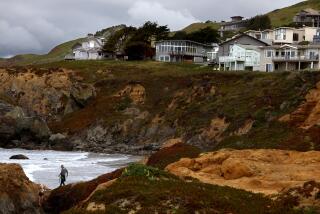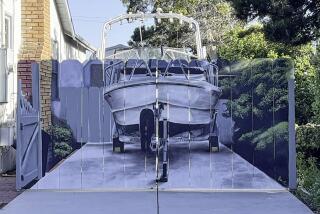Slipping Into the Marina : Boats: With the depressed economy, the character of the live-aboard clientele at Marina del Rey has changed. Many clandestinely make their dockside homes on creaky vessels and duck residency fees.
The best time to spot the “sneak-aboards” is in the early morning, at shower time.
Their boats, after all, are hardly the showpieces of the marina, and don’t have the amenities of the gleaming yachts with wood-paneled libraries and sunken Jacuzzis.
They live instead on motorless old houseboats, on creaky sailboats bought at foreclosure auctions, or on fishing craft well past their prime, with boarded-up windows and blue tarps draped over the back for makeshift shelter--not the sort of vessels likely to feature stall showers or even, in many cases, working toilets.
So, about 7 a.m., you can see them line up at the communal baths outside the 19 anchorages that make up Marina del Rey, preparing to go to work--or spend another day bumming around the docks.
There are legal live-aboards, too, throughout Marina del Rey, those who register with the dock masters and pay extra fees for living on their boats. But in hard economic times, almost everyone on the docks agrees that they are easily outnumbered by the sneak-aboards--a renegade breed who refuse to register or pay the live-aboard fee, instead keeping a low profile while “cultivating the low-overhead lifestyle,” as one put it.
Typical of them is a fledgling film and commercial producer who has made a 27-foot sailboat his home for the past year.
Hard hit by the recession, the 26-year-old said he was unable to afford his house in Burbank any longer. His search for a cheaper place led him to one of the most desirable spots in Southern California.
He got a boat without an engine through the Recycler for free, already in a boat slip. It costs him $240 a month, utilities included--less then a one-bedroom apartment around Los Angeles.
“It was the best move I ever made in my life. And I don’t want to leave,” said the marina resident, who asked that his name not be used.
As at most harbors, living on a boat is permitted in Marina del Rey and has long been a way of life for a colorful subculture of die-hard sailors, bohemians and romantics. At the marina, which is owned by Los Angeles County and regulated by the Department of Beaches and Harbors, the rules have remained the same for two decades: The craft must meet a single requirement to qualify as an abode--a working toilet--and tenants must register with dock masters and pay the extra fee, normally a 50% surcharge on the slip rental.
But with 5,265 boat slips around Marina del Rey, only 247 people were reported living there legally as of December, 1992, according to the harbor master’s office.
*
Dock masters and boaters estimate that more than twice that many people live on boats covertly.
“They have really exploded over the last year and a half,” said Tony Cione, dock master at Tahiti Marina, one of Marina del Rey’s 19 anchorages. “It is a sign of the times.”
He and others say sneak-aboards were far less common during the 1980s, when anchorages reported 100% occupancy and waiting lists. But vacancy rates began to rise about 1990, as the region’s economy fell into its slump, until 10% of the slips were empty around the marina last year. As a result, anchorages have been engaged in a price war to attract boaters, with some charging as little as $6.50 a foot for a 30-foot slip--meaning the owner of a vessel that size pays just $195 a month.
Cione said the low rates attracted a new clientele, almost the flip side of the popular image of the wealthy yacht crowd. “They are louder and rowdier; you can see it in the people and in the cars they drive,” he noted. The cars are more likely to be old Chevys than Mercedeses.
In addition, out of a desire to keep slips filled, some dock masters look the other way when they sense someone is living aboard without paying the surcharge.
Some upscale docks, such as Villa del Mar, are tough about policing their waters. “We are so strict that we don’t have a bunch of live-aboards,” said Kelly King, dock master at the facility, one of the most expensive anchorages, charging $13 a foot.
Villa del Mar limits live-aboards to 10% of its 200 slips, screens boats by appearance and offers extra amenities to the floating residents: their own mailboxes, use of a pool and Jacuzzi, and access to a clubhouse, gym and tennis courts.
But such high-scale haunts are not where you’ll find Michelangelo Kowalski.
An out-of-work actor, 32, who admits he knows nothing about boating, he bought a 1961 Cutter Rig from a friend for $350 last summer and immediately moved on board at the Tahiti Marina.
At Tahiti, anyone may live aboard. Cione simply charges more than some comparable docks, about $11 a foot, to cover the extra maintenance and utility costs generated by full-time residents. The policy means he does not have to search out sneak-aboards. “It’s not worth the bookkeeping and running around trying to find them,” Cione explained.
Nevertheless, he finally evicted Kowalski because of a problem any landlord could understand--failure to pay rent--and because the actor’s 27-foot craft stretched the limits of what is acceptable even in his tolerant marina.
Kowalski’s boat could not sail because he cut the mast trying to enlarge the cabin. Potted plants, broken bicycles and dirty dishes were piled on the dock alongside it. Plywood cluttered the bow, windows were boarded up, and an old tire sat in a dinghy next to his vessel.
“The dock master made it clear that he didn’t want me here,” Kowalski said on the day he prepared to have his home towed to another marina. “He even untied my boat.”
Cione, in turn, emerged from the encounter lamenting the new breed of boater. “We have to face the fact that there is a whole new subculture, and we are contributing to it,” the dock master said. “We let it all get out of hand.”
Dock masters who try to crack down on sneak-aboards monitor cars regularly parked overnight in adjacent lots, post memos reminding boaters of the rules and confront those who some also call “squatters” or “hide-aboards.”
But Doug Gould, dock master for the Deauville Marina, said it is difficult to prove that someone is living illegally on a boat--largely because it is legal at most places to spend three nights a week on board, as weekend boaters often do.
“As long as someone is not being a nuisance, it is kind of a live-and-let-live situation,” Gould said.
His anchorage of 400-plus slips until recently had far more sneak-aboards than registered live-aboards, he said. But a crackdown got about a dozen of them to start paying the fees, so he now has 40 registered residents.
Still, he has sympathy for boaters’ reluctance to cough up the surcharges that seem an “outrageous gouge” to some. “For someone whose dad owns a boat, or they can get a boat cheaply, it is a really cheap way to live in west Los Angeles,” Gould said.
*
There is talk among the sneak-aboards of organizing against any push to drive them from the marina. Daniel--who, like most of the sneak-aboards interviewed, declined to give his full name--said about 10 living along his anchorage have discussed leaving in unison if any is evicted. “Each dock is just like a neighborhood,” he said.
Other sneak-aboards say that, if forced to pay the live-aboard fee, they might simply move to another dock--and start life as a sneak-aboard there.
Gould, who oversees Deauville Marina, knows there’s a risk of driving boaters to other anchorages when he demands they pay extra. “It is hard to decide to kick out 30 boaters,” he said, noting that rates already have dropped from $10 to $6 a foot over the last four months because of vacancies.
Though one film construction coordinator even has a computer (to write poetry) on the houseboat he calls “the Cadillac” of sneak-aboard life, living conditions for many are hardly glamorous.
Sacrifices include space and comfort, especially during the winter, when many of the “homes” leak in the rain and test their occupants’ sea legs. “The boats rock a lot and some people get sick,” Daniel said.
The sneak-aboards also have to watch their backs, worried that one of the registered live-aboards will turn them in.
But some of mainstream weekend boaters relish the society of sneak-aboards, who provide 24-hour eyes and ears on the docks and whose presence helps make the marina come to life in the evenings, with laughter, music and impromptu parties.
“We try to keep it quiet around here,” one of the sneak-aboards said of their life on the water, “because when you got a good thing, you want to keep it.”
More to Read
Sign up for The Wild
We’ll help you find the best places to hike, bike and run, as well as the perfect silent spots for meditation and yoga.
You may occasionally receive promotional content from the Los Angeles Times.






